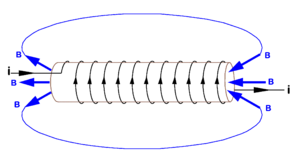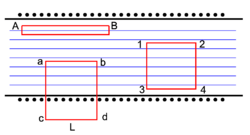Solenoid (physics)
In physics, a solenoid is a spiral of insulating wire wound around a cylinder. When a direct current passes through the wire a magnetic field is generated. Usually the cylinder is made of iron or another ferromagnetic material that enhances the magnetic field.
The solenoid behaves like a (permanent) bar magnet with two poles: the North pole (the left side of the solenoid in the figure on the right) and the South pole (the right side of the depicted solenoid).
If the diameter of the cylinder is very much smaller than its length, the magnetic field H inside the solenoid, far from its left and right side, is homogeneous and of strength
where N, the number of turns of wire per unit length, is assumed to be constant over the length of the cylinder. Further i is the amperage—the strength of the direct current running through the wire.
When the cylinder consists of a material with relative magnetic permeability μr then (in SI units) the magnetic induction (also often referred to as magnetic field) is,
where μ0 is the magnetic constant. Diamagnetic (e.g., gaseous nitrogen) and paramagnetic (e.g., gaseous oxygen) materials, have μr–values very close to unity. Ferromagnetic materials, like iron, have usually non-constant values that may vary, depending on |H|, by an order of magnitude. Materials with 10000 ≤ μr ≤ 50000 are known.
We see that the magnetic field H might be thought of as the magnetic field produced by the flow of current in the wire and the magnetic induction B as the total field, including also the contribution of the material inside the solenoid. The magnetizing field H may be weak, but the actual average magnetic field B inside the solenoid filled with ferromagnetic material maybe several orders of magnitude stronger, because B is greatly enhanced by the alignment of the material's natural atomic magnets in the direction of the field.
Magnetic field in infinitely long solenoid
By definition an "infinitely long" solenoid is so long that end effects are negligible for almost all of the solenoid. We will consider the part of a cylindrical solenoid where end effects are negligible, so that in effect we will consider an infinitely long cylindrical solenoid.
Because of cylinder (axial) symmetry, the magnetic field inside the solenoid is parallel to the cylindrical axis Z. In the figure on the left the field lines are given in blue. The fact that the field is parallel, is intuitively clear, but can be shown more rigorously.
Namely, one can show that the X-Y components of all field vectors B cancel each other. (The X-Y components are the projections of the vectors B onto a plane—the X-Y plane—perpendicular to Z). This cancellation has the consequence that only the components of the field vectors along Z contribute to the field, or in other words that the magnetic field is parallel to Z.
To show the cancellation of the vectors in the X-Y plane, we note that a cylinder has infinitely many vertical mirror planes, i.e., mirror planes that pass through the Z axis. Suppose now that an arbitrary field vector B is not parallel Z. Choose the orthogonal X and Y axis such that B is in the Z-Y plane. Note that B has a component along the Y axis. The Z-X plane is a vertical mirror plane. Reflection of B in the Z-X plane gives the vector B', which is also in the Z-Y plane. The components of B and B' along the Y axis are of opposite sign and of the same length, so they cancel each other. By reflection symmetry every B has a counterpart B' of which the X-Y components cancel.



